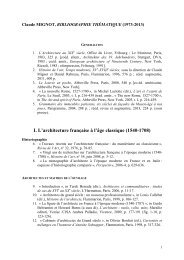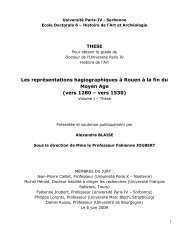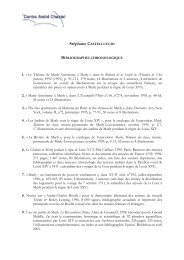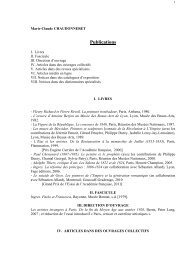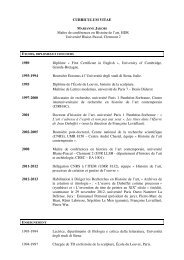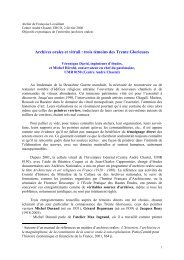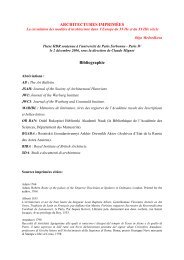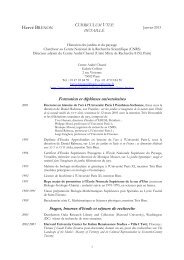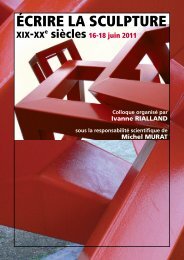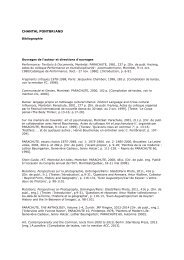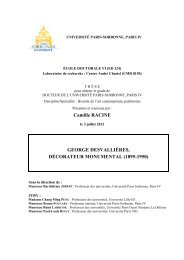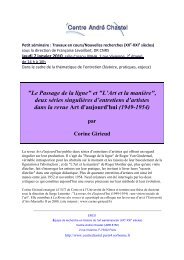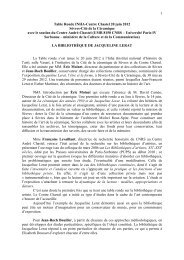lundi 3 juilletRésumés des communicationsLisa Pilosi, Mark Wypyski,Sarah Barack and Drew AndersonEarly Acid-Etchingof Stained Glass : the Written EvidenceFig. 1 New York,The Metropolitan Museum of Art (accession number1996.262. Ruth and Victoria Blumka Memorial Fund and TheCloisters Collection, 1996) : Adoration of the Magi, circle of theStrassburger Werkstattgemeinschaft ; 1507.The selective removal of the colored layer of flashedglass by etching with nitric acid is described in theearly fourteenth century treatise of Antonio da Pisa 1and in the fifteenth century Bologna Manuscript 2 .To amodern reader, this seems like an impossibility sinceonly hydrofluoric acid will etch modern glass.Nevertheless, a number of acid-etched panels havebeen identified throughout Europe,which predate the« official » discovery of hydrofluoric acid in the lateseventeenth-eighteenth century. A sixteenth centurysouthern German donor’s letter specifically calls forthe use of etching in the coats of arms,suggesting thatthe technique was known amongst stained glasscraftsmen of the time 3 .This gives rise to two (not necessarilymutually exclusive) possibilities - that nitricacid will etch glass and/or that hydrofluoric acid wasused much earlier than previously thought. In fact,several informal experiments have shown that nitricacid will etch glass with a relatively low silica and relativelyhigh lime content 4 . In addition, from the seventeenthcentury on, numerous texts describe thedissolution of the mineral fluorite in sulfuric acid andits corrosive effect on glass 5 .The exploitation of fluoritemines in central Europe from the fifteenth centuryand the contemporary use of fluorite as anartist’s pigment, coupled with the occurrence of acidetchingin stained glass panels from the same regionsuggests some sort of connection.This study investigates the techniques of etching glassdescribed in the historic treatises.Model glasses wereproduced with specific compositions to mimic anaverage potash glass typically encountered in medievalwindows and a high lime potash glass (that correspondsto the etched glass on a panel depicting theAdoration of the Magi, by an artist of the circle ofthe Strassburger Werkstattgemeinschaft, dated1507 in The Metropolitan Museum of Art) (Fig. 1).Etching trials using nitric acid and fluorite/sulfuricacid were conducted in a controlled laboratoryenvironment. Scanning electron microscopy andX-ray microanalysis were used to characterizethe effectiveness of the process (i.e. the depth ofetching), the morphology and any chemical changesevident on the etched surfaces.1. Vetrate Arte e Restauro : dal Trattato di Antonio da Pisa alle nuovetecnologie di restauro, Milan, Silvana Editoriale, 1991.2. Merrifield (Mary P.), Original Treatises on the Arts of Painting, vol. 2,New York, Dover Publications Inc., 1967, chapter 217, p. 494-495.3. Schleif (Corine) and Schier (Volker), « Views and Voices fromWithin : Sister Katerina Lemmel on the Glazing of the Cloister atMaria Mai », Glasmalerei in Kontext : Bildprogramme undRaumfunktionen : Akten des XXII Colloquiums des <strong>Corpus</strong> <strong>Vitrearum</strong>,Nürnberg 29. August-September 2004 (Anzeiger des GermanischenNationalmuseums, wissenschaftlicher Beiband 25), éd. RüdigerBecksmann, Nüremberg, 2005, p. 6.4. Verità (Marco), « Commento Tecnico al Trattato di Antonio daPisa », Vetrate Arte e Restauro, op. cit note 1, p. 99-100 ; Scholz(Hartmut), Hess (Daniel), Rauch (Ivo), Kölzer (Norbert) andWindelen (Barbara), « Beobachtungen zur Ätztechnik an Überfanggläserndes 15. Jahrunderts », <strong>Corpus</strong> <strong>Vitrearum</strong> News letter, 46,1999, p. 19-23.5. Charleston (Robert J.), « Part 5-Acid Etching on Glass », TheGlass Circle, no. 3, 1979, p. 31-39 ; Cassebaum (Heinz), « NeueAspekte zur Entdeckung des Ätzens von Glas », Silikattechnik, 34,Heft 7, 1983, p. 213-215.16
Résumés des communicationslundi 3 juilletJean-Pierre Delande et Isabelle LecocqLes traités techniques : formalisation, codification,transmission et actualisation des croyances,des savoirs et savoir-faire ancestrauxLa connaissance et la compréhension de la techniquedu vitrail ancien passent par l’analyse des traités,notamment le fameux Diversarum artium schedula duprêtre Théophile, le traité d’Antoine de Pise, le traitésur la peinture de Cennino Cennini, et le manuscritde Bologne 1 .Les historiens du vitrail qui sont surtoutfamiliarisés avec le livre quatre de la Diversarumartium schedula seraient peut-être surpris d’apprendreque ce passage-ci est également de Théophile :« Il y a aussi l’or qui est appelé espagnol,et qui est faitavec du cuivre rouge, de la poudre de basilic, du sanghumain et du vinaigre. Les païens, dont l’habileté encet art mérite l’approbation, se font des basilics de lafaçon suivante.Ils ont sous la terre une habitation quiest en pierre en haut, en bas et de tous côtés, avecdeux petites fenêtres si étroites qu’à peine un peu delumière y passe ; ils y mettent deux vieux coqs dedouze ou quinze ans, et ils leur donnent une nourrituresuffisante. Quand ils sont engraissés, à cause dela chaleur de la graisse ils copulent entre eux et pondentdes œufs […] » 2 . Les recettes de ce genre sontlégion. Elles sont bien connues des historiens destechniques qui nous ont offerts de précieuses observationsméthodologiques 3 . Robert Halleux etCamélia Opsomer, qui se sont penchés sur celles-ci,ont montré qu’il s’agit d’un des premierstémoignages de l’alchimie en Occident. Ils soutiennentfermement l’hypothèse de l’identification deThéophile avec l’orfèvre Roger de Helmarshausen 4qui était manifestement en étroite relation avecl’abbé Wibald de Stavelot (1098-1158) et lethéologien Rupert de Deutz (vers 1075-1129).Cette identification expliquerait la présence àStavelot vers 1200 d’un abrégé de la Schedula.À son tour, le texte de Théophile a suscité etnourri des compilations où l’on retrouve lemême mélange curieux entre relation d’unsavoir-faire et recettes ésotériques. Parmi cellesci,citons le Trésorier de philosophie naturelle despierres précieuses du liégeois Jean d’Outremeuse 5et un texte du « moine de Zagan » 6 .Ces deux sources témoignent de deux usagesdifférents du traité du moine Théophile, pour lapartie consacrée à la technique du vitrail proprementdite : simple compilation d’une part, etapproche raisonnée de l’autre, avec intégrationde nouveaux passages sur la pratique du métier,d’une importance capitale pour la compréhensionde la technique du vitrail ancien.La discussion autour de ces deux traités seral’occasion d’examiner le bien fondé aux pointsde vue physique et chimique de certainesrecettes et modes opératoires.1. Pour un aperçu du contenu et de l’apport de ces traités, voirnotamment Strobl (Sebastian), Glastechnik des Mittelalters,Stuttgart, 1990.2. Halleux (Robert) et Opsomer (Camélia), « L’alchimie deThéophile et l’abbaye de Stavelot », Comprendre et maîtriser lanature au Moyen Age, Mélanges d’histoire offerts à Guy Beaujouan(École pratique des hautes études - IV e section, Sciences historiqueset philologiques), Hautes études médiévales et modernes,73, Genève, 1994, p. 436-460.3. Depuis 1989, le <strong>Centre</strong> d'Histoire des Sciences et desTechniques de l’Université de Liège, dirigé par Robert Halleux, aentrepris de constituer une grande base de toutes les données detoutes les recettes techniques du Moyen Âge : pour chaque technique,les différentes formules sont classées par ordre de ressemblancedécroissante et pour chaque substance, les utilisations dansles divers arts et métiers regroupées.Voir Robert Halleux, « Lestechniques du verre dans les anciens manuscrits de recettes »,Technique et science. Les arts du verre, Actes du Colloque de Namur1991, 20-21 octobre 1989, Namur,1991, p. 19-30.4. L’identification de Théophile à Roger de Helmarshausen, vivementdébattue, n’est pas acquise (voir Madeline Caviness, Stainedglass windows, Typologie des sources du Moyen Âge occidental, 76,Turnhout, 1996, p. 46, note 2 et Ehrard Brepohl,Theophilus Presbyterund mittelalterliche Kunsthandwerk, I, Malerei und Glas, Cologne-Weimar-Vienne, 1999, p. 22-31).5. Cannella (Anne-Françoise), Gemmes, verre coloré et fausses pierresprécieuses au Moyen Âge, Le quatrième livre du Trésorier dePhilosophie naturelle des pierres précieuses de Jean d’Outremeuse,Thèse présentée en vue de l’obtention du grade de Docteur enHistoire de l’Art et Archéologie, Liège, 2001.6. Wackernagel (Wilhelm), Die deutsche Glasmalerei, Leipzig, 1855,p. 172-176 et Strobl, op. cit., p. 218.17



